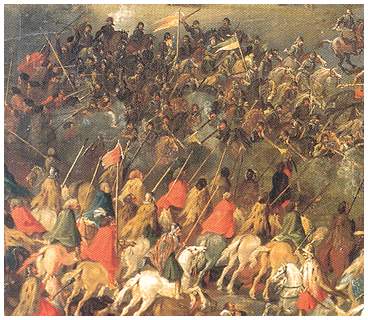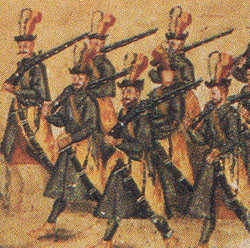|

Second Half of 15th Century
First
Half of 16th Century
Second
Half of 16th Century
First
Half of 17th Century
Reforms
of 1632-1633
Second
Half of 17th Century
The
end of 17th Century
|
 |
Beginning of the 17th Century
 At
the start of the 17th Century the army was composed mainly of cavalry
and its commanders, though having fought in Batory's Muscovite campaigns,
had more confidence in the use of cavalry than the methodical and
thorough Western way of taking important towns and castles and then
fortifying captured territories. The basic Polish aim was to destroy
the enemy's main field army; however, victory on the battlefield
did not always lead to victory in the war and problems were met
when the enemy avoided battle and hid behind fortifications. Examples
of the cavalry campaigns were the war in Livonia (1600-1609) and
the war in Muscovy (1609-1618). The infantry were used mainly in
the few sieges and to garrison captured castles; in battle few were
used, although their firepower played an important role. We see
that large numbers were used at Chocim (1621), but this is because
the fighting was mainly in the defence of fortifications. At
the start of the 17th Century the army was composed mainly of cavalry
and its commanders, though having fought in Batory's Muscovite campaigns,
had more confidence in the use of cavalry than the methodical and
thorough Western way of taking important towns and castles and then
fortifying captured territories. The basic Polish aim was to destroy
the enemy's main field army; however, victory on the battlefield
did not always lead to victory in the war and problems were met
when the enemy avoided battle and hid behind fortifications. Examples
of the cavalry campaigns were the war in Livonia (1600-1609) and
the war in Muscovy (1609-1618). The infantry were used mainly in
the few sieges and to garrison captured castles; in battle few were
used, although their firepower played an important role. We see
that large numbers were used at Chocim (1621), but this is because
the fighting was mainly in the defence of fortifications.
The Cavalry
At first the
cavalry was mostly composed of the hussars, but in support increasing
use was made of Cossack cavalry in kolczuga (mailcoat) and misiurka
(mail helmets) mounted on lighter horses and in the main armed with
bows and arquebuses, as well as shields, war hammers, pistols and
lances. Their numbers increased so that by the early 1620's they
and the unarmoured Cossack Cavalry composed the largest cavalry
type. They were used with great flexibility in close or open order
(i.e. melee or skirmishing). In Lithuania there were similar cavalry
called petyhorcy and czeremisy
who tended to use lances more. The unarmoured Cossacks
remained and were used as a lighter arm for manoeuvre, other light
cavalry included Wallachians and Lithuanian Tatars.
 The
Infantry The
Infantry
The infantry - wybraniecka, mercenary
(Polish and Hungarian) and Zaparozian - was primarily firepower
infantry and was very useful in support of the cavalry, but did
not yet form an independent arm of its own. Since the beginning
of the 17th Century the arquebus was being replaced by the more
powerful musket. This necessitated the use of a rest and the introduction
of the counter march system of firing. The largest organisational
unit was still the rota, but the
term pulk was used to cover units
under the same commander.
The
Artillery
Although at first there was a fixed grant from the Sejm
for the artillery, this practice declined later in Sigismund's reign
and the numbers of cannons in the Royal army decreased. Their use
tended to be reserved for sieges and only small numbers of light
cannons were used on the battlefield. The quality of training and
technology, however, remained relatively high and a school for artillery
men was formed which later produced some excellent artillery commanders.
A major impact
on the Polish army was Gustav Adolphus' invasion of Prussia with
a reorganised and well-trained Swedish army. The powerful Swedish
firepower superiority, coupled with field defences and skilful manoeuvring,
meant that the Polish cavalry were no longer in a position to defeat
the Swedes by themselves. The need for an independent infantry arm
was realised, but attempts to hire large numbers of mercenary pike
and shot infantry were hampered by the Sejm,
which did not believe their extra cost in comparison to the Polish-Hungarian
infantry was justified. The main reorganisation of the army occurred
only when Zygmunt's
son, Wladyslaw IV (Vladislav) became King, although the use of pike
and shot infantry increased from 1627-28.
 4
4 
|
|

Page 4
|

![]()

